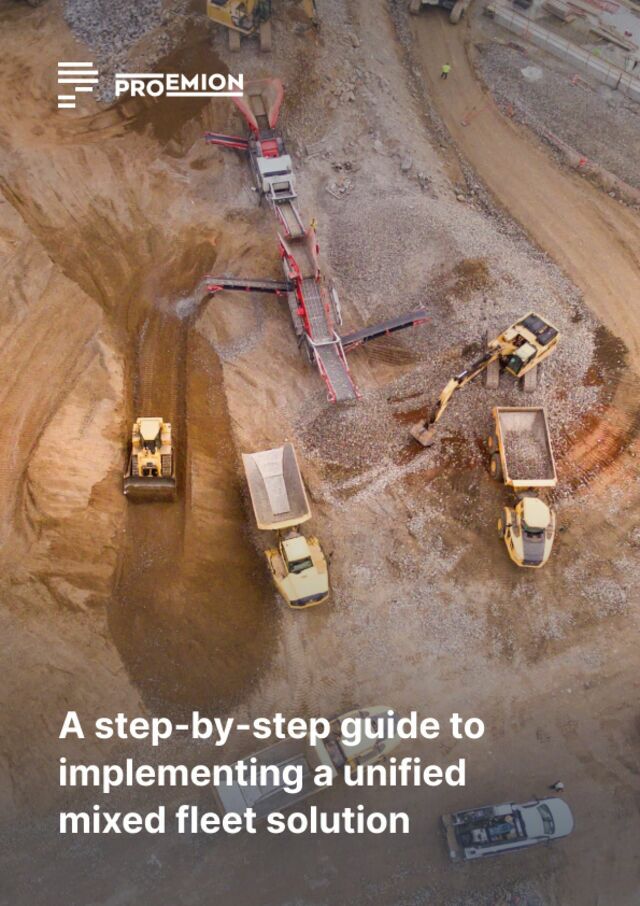The AEMP Standard
What is it, how can it be used, and what are its benefits?
Table of content
- Executive Summary
- Introduction
- The origins of the AEMP API
- The AEMP API increases profitability in the construction industry
- How Proemion delivers mixed fleet telematics using the AEMP API and third-party data
- Challenges associated with polling the right AEMP telematics data
- Applying common sense to use cases
- An outlook on the possibilities of the AEMP API
- Getting started with a Proemion mixed fleet solution you can trust
Executive Summary
This white paper seeks to present an informative overview of the AEMP API, its origins, and where it can be included in the telematics solutions for off-highway heavy machinery independently of the OEM.
After a brief introduction to the background of the AEMP API, we give an example of it in use and discuss how the AEMP API supports profitability in the construction industry.
Furthermore, we explore how the AEMP API is used to deliver data from different OEMs and some of the challenges associated with polling the right telematics data provided by the API. We also discuss factors influencing AEMP data quality - availability, accuracy, and frequency - and the need to standardize when interpreting data and building use cases.
Finally, we give a small outlook into the possibilities that the implementation of AEMP API in construction businesses can offer.
We appreciate that the industry is starting to adopt the AEMP standard. AEMP allows all telematics providers to share a single data collection, which opens up opportunities for integration and increases machine owners' efficiency and productivity.
With AEMP, the construction industry appears to have a brighter and more inventive future.
Introduction
Telematics is the branch of information technology that deals with the long-distance transmission of computerized information. They deliver essential information on your machines and thus enable you to manage your fleet efficiently and make data-driven decisions for your business.
In order to optimize the management of an off-highway mixed fleet, a unified portal for collecting and analyzing accurate telematics data is critical. Dependable usage, condition, maintenance, and operational data are essential inputs that help build reliable use cases and deliver value to the business.
However, since most OEMs equip their machines with their own telematics systems, there can be a considerable variation in how the different systems of a mixed fleet provide and present their data. This also presents a challenge to mixed fleet managers, who need a concise overview of all data to make informed business decisions.
This is where the AEMP API delivers value by providing standardized, insightful telematics data across a mixed fleet of off-highway machines.
The Association of Equipment Management Professionals (AEMP) establishes standards for construction equipment telematics, which is called the “AEMP API”. The AEMP API normalizes machine data from different OEMs to a consistent naming convention and calculation standard.
The origins of the AEMP API
The Association of Equipment Management Professionals (AEMP) is an organization created for companies that manage and maintain heavy, off-highway fleets. It sets benchmarks and standards for best practices with telematics data, including a standardized format and data type.
AEMP has strongly advocated for the consolidation of industry standards. In 2016, this advocacy resulted in establishing ISO standards for construction equipment telematics, often referred to as the “AEMP API “.
The AEMP API is an ISO standard for communicating construction equipment telematics data for select off-highway asset classes. It relates to ISO standards initially proposed by AEMP in version 1.0 in 2010 and further developed for general use in version 2.0 around 2016. The AEMP technical standard is “ISO 15143-3”.
It is important to note that many of the standards contained in AEMP are optional. Hence, strict compliance with AEMP is by no means guaranteed - levels of compliance may vary between OEMs and third-party telematics vendors.
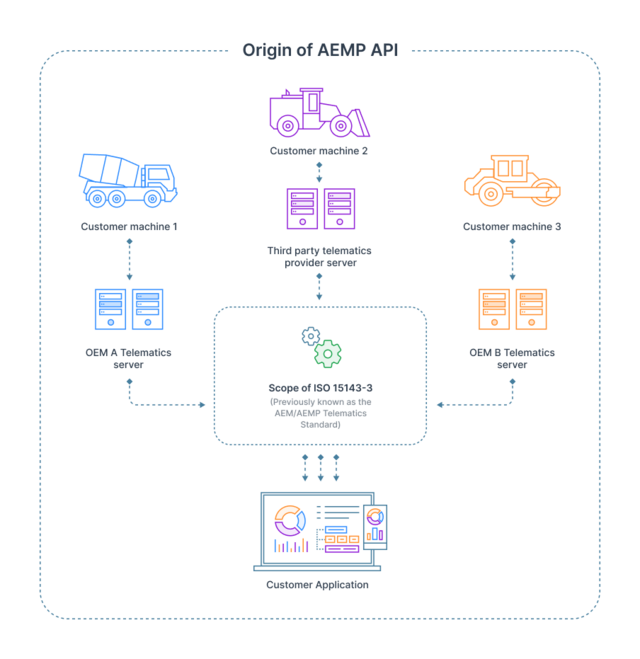
The AEMP API increases profitability in the construction industry
The pressure on modern businesses to increase revenues and profitability while reducing costs is unrelenting, leaving them with no other option but leveraging every asset at their disposal.
Savvy construction industry professionals are already taking advantage of the valuable insights the AEMP API delivers to drive financial performance, increase efficiency, and provide tangible benefits to end-users.
OEMs generally provide their own version of telematics solutions, which means that creating an accurate unified view of your fleet is challenging if you have a fleet from various suppliers. Merely pulling data from disparate sources without regard for its quality is a flawed methodology many vendors employ.
Taking advantage of modern telematics solutions, including those using data polled from the AEMP API, is becoming less a matter of choice and more a necessity for businesses that want to remain competitive.
How Proemion delivers mixed fleet telematics using the AEMP API and third-party data
We collect data that conforms to AEMP (Association of Equipment Management Professionals) standards from OEM (Original Machine Manufacturers/3rd party) cloud solutions. Then, we clean and standardize the data (our Data Check) before passing it to our own cloud platform, DataPlatform, for processing, storage, and interpretation via our web portal, the DataPortal, or any other place chosen by the data owner.
Our mixed fleet solutions help construction companies, rental companies, and machine owners take their fleet management to another level by getting rid of paper-based processes and digitalizing them. This allows them to improve efficiency and increase productivity.
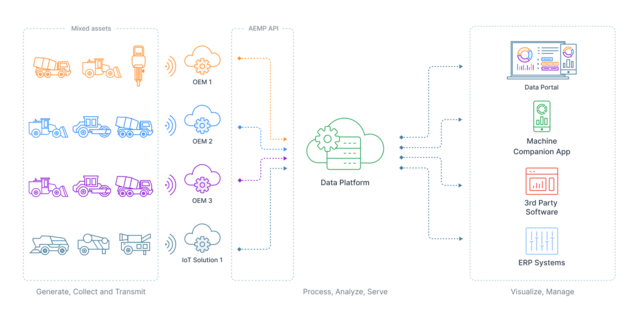
Examples of OEMs we partner with
Since our inception in 1987, we have established close relationships with various well-known OEMs. As a result, we have developed the in-house knowledge and experience to provide our customers with standardized mixed fleet solutions that poll data from the biggest suppliers in the off-highway machine and equipment sector.
Challenges associated with polling the right AEMP telematics data
Getting the correct AEMP data from a disparate fleet of off-highway machines and equipment is not a trivial process. Certain factors influence the overall quality of data, and since different OEMs offer different telematics solutions, they often provide different data at different frequencies. These factors then also heavily influence your ability to build reliable use cases that deliver value.
Maybe we are not getting location data from a machine because it is not configured to supply it. Or perhaps we are not getting location data because the data cloud owner is not providing location data via the AEMP interface.
As data challenges are identified, it is important to communicate them and give input for the investigation backward in the data trail to find a solution. Some of the most important aspects of data that need to be validated are its availability, accuracy, and frequency.
In order to use telematics data, especially to build use cases, it must be available in the first place. Data availability challenges do not exist strictly at the individual OEM level, as you might initially suspect. They can be as granular as specific machines from the same OEM.
For example, one OEM might provide operating hours data for some models and not for others. This means you cannot rely on this specific OEM machine to give the same data. It could be that some machine models do not provide certain data, or even particular machines do not provide it.
Inaccurate telematics data delivers faulty predictions and will not support accurate use cases. In turn, relying on a use case backed by inaccurate data only wastes time, money, and resources. Conversely, use cases built on known accurate telematics data enhance decision-making, increase productivity and efficiency, and reduce cost. The more accurate your data, the better the ROI without incurring any additional expenditure.
Inaccurate data may originate from machines that have some kind of telematics problem in their configuration.
Data values are generally accurate. However, data supplied with anomalies can sabotage analyses and render the data useless.
Similarly, inaccurate data showing up in some counter metrics, such as operating hours, causes a problem. For example, an operating hours counter should only increment, but we have seen cases where operating hours went up and down. Again, this inaccurate data can be “cleaned” but it breaks reports and analytics until it is.
The frequency of data refers to how often we poll data from the OEM cloud, and there are important considerations here.
Different use cases require different frequencies of data updates. For example, monitoring fuel usage and planning refueling ideally requires a data update on an hourly basis. In contrast, a weekly operating hours update may be sufficient for a planned maintenance use case.
However, just because we poll data every 5 minutes does not mean the OEM updates the data with the same frequency. A good analogy that illustrates the implications of this is to consider what happens with an online Google Doc.
Assume an OEM writes something in a Google Doc whenever he wants, for example, every 20 minutes or every hour. As Proemion (or the machine owner), I look at the Google Doc every 5 mins, but that does not mean the document is going to be updated with the same frequency I interrogate it, or at all. I cannot change that. If the OEM only provides data once every hour, I cannot get more frequent updates - it is not something I can influence. As Proemion, we can only show and advise machine owners to request OEMs to deliver the data as they need once machine owners are the data owners.
Applying common sense to use cases
You do not need all data delivered with super high frequency to build valuable use cases. In fact, for some machines, that is something that will never happen.
As a rule of thumb, if a simple report shows that 90% of your fleet delivers the right data with the right frequency, it is already valuable and can provide significant business value.
So, whether you can build a successful use case depends on whether problematic machines constitute a large percentage of your fleet. If it is only 1 or 2 machines in a large fleet, common sense dictates it may not be a problem, and you can still build a valuable use case.
In fact, if the number of problematic machines is sufficiently low, the effort required to drill down into their individual shortcomings may not even be justified.
An outlook on the possibilities of the AEMP API
Collecting and analyzing accurate AEMP data (via the AEMP API) from disparate OEMs through a unified portal optimizes managing off-highway mixed fleet machines. In addition, implementing an AEMP API can take fleet management to another level, unlocking business opportunities and increasing efficiency and productivity.
Some benefits to construction companies of implementing a unified telematics solution for the mixed fleet include:
- Data Harmonization
- Reduced operational cost (through proper maintenance)
- Optimal productivity
- Improved cash flow
- Competitive edge
Typical use cases where the AEMP API can be integrated to good effect include:
Up-to-date total operating hours are crucial, even if this is done fairly infrequently. For example, for a machine that needs maintenance every 500 hours, you would typically create a maintenance ticket 40 or 50 operating hours ahead of time and open the ticket at, say, 450 hours. But, of course, this is more than a week of work ahead of time, so even if operating hours do not update every day, it is not that important.
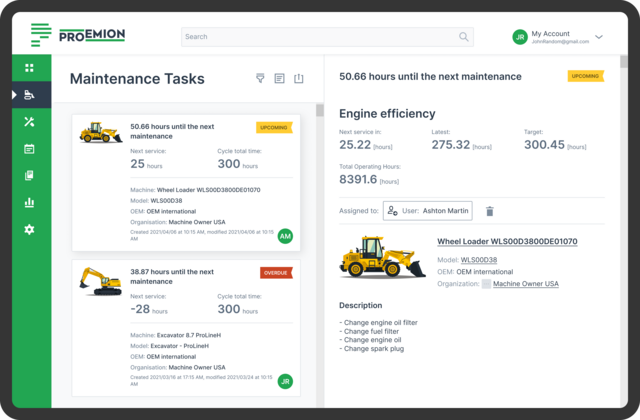
Frequency is only equally critical for some use cases. But, if we consider a fuel management use case, including monitoring machine fuel levels, refueling needs, supplier provision, ordering, and billing, the need for more frequent data updates becomes apparent. Now you need to track fuel level and fuel consumed at least every couple of hours.
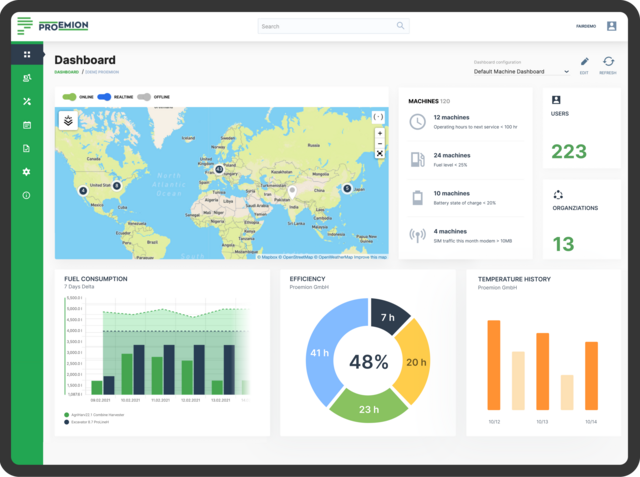
Construction and rental companies need to relocate machines regularly. To do so, they need to know the up-to-date GPS location of their machines so they can send their transporter to the correct location to pick up the machine scheduled for relocation. Getting this wrong can be costly - time wasted locating a machine, plus the knock-on effect of the new site not getting the right machine at the right time means lost productivity and the costs associated with it. Therefore, an AEMP data frequency of once every 1-2 hours is generally acceptable for this use case.
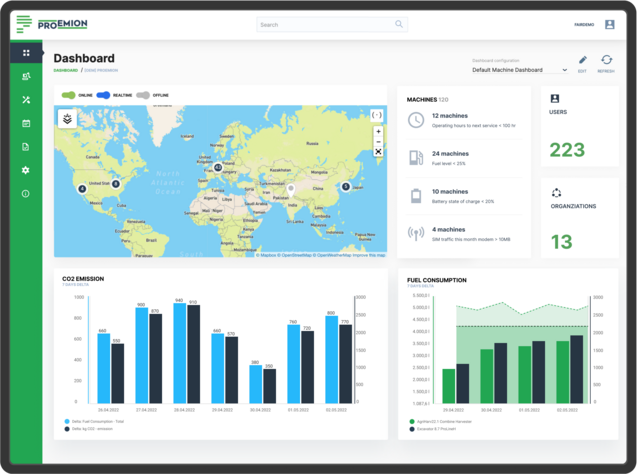
Other use cases include Co2 reporting, monitoring machine idling time, machine use optimization, and more.
Getting started with a Proemion mixed fleet solution you can trust
Creating a unified view of your mixed fleet is not a trivial challenge. To get it right, you need an experienced partner who specializes in checking and ensuring the accuracy of the AEMP data your use cases rely on. Proemion is such a partner.
Do you have a mixed fleet telematics use case for your off-highway machines you would like to explore?
Maybe you are our next success story, and we can help you elevate your current fleet management processes to a whole new level.
We will even help you validate your intended use cases, uncover powerful new use cases you may not have thought of, and guide you through the whole process from a successful pilot project to implementation.
